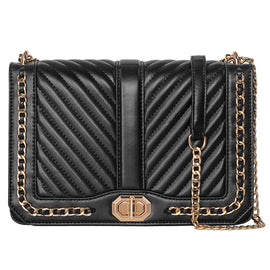Handbag hardware plays a critical role in the overall design, functionality, and durability of a bag. From connectors to fasteners, every piece of hardware serves a specific purpose while contributing to the bag's aesthetic. Whether you are a designer, manufacturer, or an informed buyer, understanding these hardware components ensures better communication with suppliers, enhances product quality, and helps you make better purchasing decisions. Below is a detailed breakdown of common handbag hardware and their uses.
Standard Hardware Colors
Handbag hardware typically comes in five popular finishes: silver, gun nickel (also known as gunmetal), light gold, brushed bronze (often called antique brass), and rose gold. These colors not only add style but also affect the overall tone of the bag.
- Silver: A versatile and timeless choice that pairs well with a wide range of bag colors and designs. It’s highly popular for its modern and polished look.
- Gun Nickel: Known for its darker, metallic finish, gun nickel offers a contemporary and edgy appearance.
- Light Gold: A softer, more understated gold tone that is elegant and frequently used in luxury handbags. It’s worth noting that light gold can vary between suppliers, so it’s essential to confirm consistency for large-scale projects.
- Brushed Bronze: Also called antique brass, this finish has a rustic and vintage appeal, perfect for retro or casual bag styles.
- Rose Gold: A trendy choice in modern fashion, rose gold adds a feminine and luxurious touch to any handbag.
Selecting the right hardware color is crucial for ensuring the bag’s design aligns with the intended aesthetic. Designers often test multiple finishes to find the perfect match.
Connector Hardware: Functional and Decorative
Connector hardware is essential for attaching straps, handles, or other components to the main body of a bag. These elements often double as decorative accents, enhancing the bag’s overall look.
1. D Rings
- Description: Shaped like the letter "D," these rings feature a flat side and a curved side.
- Functionality: Typically used to attach detachable shoulder straps or as decorative elements.
- How It’s Used: A small leather loop secures the flat side of the D ring to the bag, leaving the curved side open for strap hooks or charms.
- Aesthetic Appeal: Adds a clean, polished look to handbag designs while offering practical functionality.
2. O Rings
- Description: Fully circular in shape, these rings allow for smooth movement and flexibility.
- Functionality: Ideal for connecting straps, particularly on backpacks and multi-functional bags.
- Applications: Frequently used to link two adjustable straps or as part of the bag’s overall design.
3. Rectangle Rings
- Description: These rectangular rings are used to create structured and adjustable straps. When the sides are equal, they are called square rings.
- Functionality: Common in handbags and luggage, rectangle rings are essential for ensuring straps are secure and adjustable.
4. Triangle Rings
- Description: With their triangular shape, these rings are often seen on backpacks.
- Functionality: They are used for both aesthetic purposes and as connection points for straps.
- Applications: A great choice for designs with a sporty or casual vibe.
5. Oval Rings
- Description: Shaped like an egg, these rings are also referred to as egg rings.
- Functionality: Commonly used in pairs for strap adjustments, offering a sleek and minimalist look.
- Applications: Perfect for bags that require frequent strap modifications, such as crossbody or messenger bags.
6. O-Clip
- Description: A round snap buckle with a swing door that opens and closes.
- Functionality: Allows for easy attachment and removal of straps or accessories.
- Design Advantage: Provides a seamless appearance, especially in luxury handbag designs.
7. Strap Hooks
- Description: Also known as snap hooks or swivel clips, these are typically attached to shoulder straps.
- Functionality: They clip onto D rings, enabling a bag to be easily converted from handheld to crossbody or shoulder use.
- Additional Uses: Smaller versions are often used to attach charms, coin purses, or decorative elements to handbags.
Fasteners: Rivets and Beyond
Fasteners are small yet essential hardware components that secure various parts of the bag. The most common type is the rivet, which comes in multiple shapes and designs.
1. Rivets
- Flat Cap Rivets: These have a flat, smooth surface and are often used for minimalist designs.
- Round Cap Rivets: Also known as mushroom rivets, these have a rounded surface that adds a subtle decorative touch.
- Pyramid Rivets: A bold and edgy option for bags with a modern or urban aesthetic.
- Bucket-Shaped Rivets: These have a deeper profile, often used in utility or functional bag designs.
Applications:
- Rivets typically consist of two parts that sandwich the material, ensuring a secure hold. The visible front portion often features decorative details, such as gemstones or engraved designs.
- Protective Function: Rivets are sometimes added to the bottom of large bags or travel luggage to prevent wear and tear.
- Design Element: They can also be strategically placed as accents, enhancing the bag’s overall aesthetic.
Why Handbag Hardware is Essential
Handbag hardware is more than just functional—it’s an integral part of a bag’s design, contributing to its style, durability, and versatility. Choosing the right hardware not only ensures the bag’s practicality but also aligns it with its intended look and purpose.
By understanding the role of each component, from D rings and strap hooks to rivets and O-clips, designers and buyers alike can create and select handbags that are as functional as they are beautiful. Whether you’re crafting a luxury handbag or choosing the perfect everyday bag, attention to hardware details makes all the difference in achieving quality and style.
If you want to customize your own bag with hardware accessories, you can contact professional expert-herminfashion













